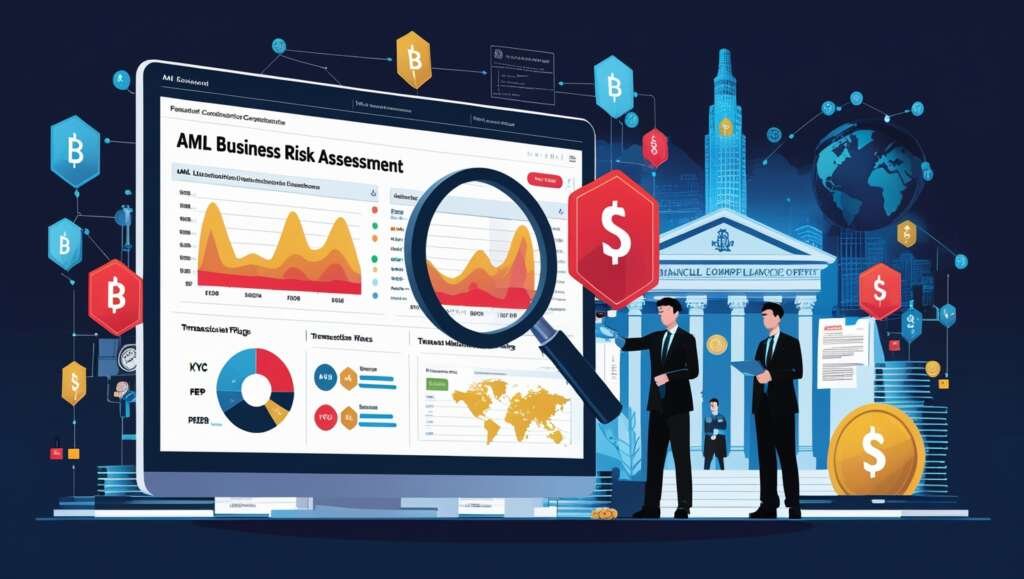You might be thinking, “My business is legitimate, why worry about money launderers?” Well, unfortunately, criminals don’t discriminate. They’re always looking for legitimate pathways to hide their ill-gotten gains. If your business doesn’t have strong defenses, it becomes an attractive target, perhaps without you even knowing.
The consequences of being exploited are severe: think massive fines, a ruined reputation that took years to build, loss of customer trust, and even potential criminal charges. This isn’t just theory; we see headlines about it globally.
Here in the UAE, especially, the government, through bodies like the National Anti-Money Laundering and Combating Financing of Terrorism and Financing of Illegal Organizations Committee (NAMLCFTC), is incredibly serious about fighting financial crime. They’ve made huge strides, even getting off the FATF ‘grey list’ recently, which speaks volumes about their commitment. This means they expect your commitment to be equally robust. Your AML Business Risk Assessment is your primary way of demonstrating that dedication.
The Recipe for Success: What Goes Into a Solid Risk Assessment?
Imagine you’re baking a cake. You need the right ingredients, right? An AML Business Risk Assessment is similar. You need to gather the right “ingredients” – information and insights – to make it truly effective.
Ingredient 1: What Are the National & Global Threats?
You can’t just focus on your own backyard. Criminals operate across borders, so your risk assessment must consider global and national trends.
- The UAE National Risk Assessment (NRA): Your Local Playbook:
The UAE’s NRA is a detailed report that tells us what the biggest money laundering and terrorism financing threats are right here in the Emirates. It’s like a national security brief for financial crime. For instance, the 2024 NRA highlighted increased risks in sectors like real estate, gold trading, and Virtual Asset Service Providers (VASPs) due to their susceptibility to large cash transactions, cross-border flows, or the misuse of legal structures.
- Why it matters to you: If you’re a VASP in Dubai, you’d be foolish to ignore the NRA’s findings that cryptocurrencies can facilitate rapid, cross-jurisdictional movement of funds, complicating tracing efforts. This tells you exactly where to bolster your defenses. It helps you understand specific “typologies” – fancy word for how criminals actually commit these crimes, like structuring cash deposits to avoid reporting thresholds, or using complex company structures to hide who the real owner is.
- The Global Standard-Setter (FATF):
The Financial Action Task Force (FATF) is the international body that sets the rules for fighting money laundering and terrorism financing. Think of them as the rulebook for the global financial game. Their guidelines, recommendations, and reports on global trends (like the increasing use of DeFi or NFTs in illicit activities) are absolutely essential.
- Why it matters to you: Following FATF guidelines means you’re aligning with international best practices. This makes cross-border business smoother and shows global partners and regulators that you’re serious. They emphasize a “risk-based approach” – meaning you should focus your heaviest defenses on your highest risks, not treat every customer or transaction the same.
- Regional Watchdogs (e.g., MENAFATF):
Just like the FATF sets global rules, regional bodies like MENAFATF (Middle East and North Africa Financial Action Task Force) adapt those rules to our specific region. Their reports often highlight unique local or regional methods of financial crime.
- Why it matters to you: These regional insights fine-tune your understanding of local vulnerabilities, ensuring your assessment is culturally and geographically relevant.
Ingredient 2: Your Business’s Operational Structure
Once you understand the external threats, you need to turn inward and assess your own business.
- Your AML Compliance Officer:
Think of the AML CO as the company’s internal guardian against financial crime. While senior management sets the strategy and approves the risk appetite, and front-line staff are the first line of defense, it’s the AML CO who ties it all together, ensuring the strategy is practical and the defenses are working on the ground.
The AML CO isn’t just someone who reads regulations; they live the daily reality of your business’s AML challenges.
-
- Day-to-Day Operations: They are intimately familiar with how your products and services are actually used by customers. They understand the nuances of your customer onboarding flows – where might a weak point be? How exactly does a new account get approved? What are the common points of friction that might tempt staff to cut corners?
- Client Interactions: They often have a direct line to client-facing teams. This means they hear about unusual customer behavior, difficult verification cases, or even direct attempts by individuals to push boundaries. This anecdotal, yet highly valuable, information provides real-world context that data alone might miss. For instance, if front-line staff consistently report that customers from a particular region are reluctant to provide Source of Wealth information, the AML CO knows this is a practical risk point to highlight in the assessment.
- Transaction Flows: They understand the intricate pathways money (or virtual assets) takes within and outside your system. They know the payment channels, the internal routing, and the typical transaction patterns. This granular understanding helps them identify where illicit funds might be hidden or moved most easily. They’re not just looking at the final numbers; they’re tracing the journey.
- Historical Suspicious Activity: Crucially, the AML CO is often the central repository of knowledge regarding past suspicious activity reports (SARs) or suspicious transaction reports (STRs) filed. They know the typologies that have actually tried to penetrate your defenses. They understand if there are recurring patterns, whether certain products or customer groups have historically generated more alerts, or if there were near-misses that highlighted a vulnerability. This historical data is invaluable for predicting future threats.
- Compliance Challenges: They are keenly aware of the practical difficulties in implementing certain controls. Perhaps a specific system isn’t integrating well, or a particular procedure is too manual and prone to human error. Their insights into these practical “pain points” are essential for a realistic assessment of control effectiveness.
-
- Why it matters to you: Their practical experience makes the risk assessment realistic and actionable. They’re the ones who’ll help implement the changes, so their buy-in and direct insight are invaluable.
- The Unique Face of Your Business (Nature & Size):
Your risk isn’t generic. It’s deeply tied to who you are as a business.
- What products/services do you offer? If you’re a VASP dealing in privacy coins, your risk is inherently different (and often higher) than a traditional retail bank primarily handling local salaries. Offering high-value real estate transactions or precious metals dealing (as highlighted in the UAE NRA) also carries specific risks.
- Who are your customers? Are they individuals, complex corporate structures, Politically Exposed Persons (PEPs), or clients from high-risk countries? Each customer type brings a different level of risk.
- How do you deliver services? Are you entirely online, making customer verification more challenging? Or do you have physical branches?
- Your geographic reach: Do you have clients or operations in countries known for corruption or weak AML controls?
- Your transaction volumes/values: High volumes, especially fast, cross-border payments, can increase risk.
By combining all these ingredients – the national and global intelligence with your specific business characteristics and your AML CO’s insights – you get a clear, comprehensive picture of your potential weak points.
The Process: Your Step-by-Step Guide to a Robust AML Risk Assessment
Alright, now let’s talk about the actual “doing” part. The AML Business Risk Assessment isn’t a one-and-done project. It’s a continuous, methodical process, much like a regular health check-up for your business.
Step 1: A Business Overview
Before you can assess risks, you need to know every corner of your business. This is your foundation.
- What are we doing? List out all your products and services. For a VASP, this could be crypto-to-fiat exchange, crypto lending, staking, custody services, NFT marketplaces, or even advisory services. For a bank, it’s current accounts, loans, international transfers, trade finance, etc. For each, think about how it works – can it be done anonymously? Does it involve fast, cross-border movement of funds?
- Who are we serving? Describe your customer types. Are they retail individuals, large corporations, trusts, non-profit organizations, or perhaps other financial institutions? Where are they located? What’s their typical activity?
- Where are we operating? List all the countries you do business in, where your customers are based, and even where your technology infrastructure is hosted. Identify which of these are considered “high-risk” by international bodies or national authorities.
- How do we connect? What are your delivery channels? Are customers onboarded online? Through agents? Face-to-face? Each channel has its own risks.
- Who’s involved? Think about your staff and any third-party partners (like payment processors or technology vendors). Are there risks from insider threats or weak controls by partners?
This mapping helps you see the whole picture before zooming in on specific threats.
Step 2: Identifying Risk Scenarios
Now, let’s put on our detective hats. Based on the business overview and the intelligence we gathered, how could criminals try to exploit your business?
- Brainstorming Bad Ideas: Think of specific examples.
- For a VASP: “A user from a sanctioned country uses a VPN to bypass geo-blocks and trades privacy coins on our platform.” Or, “Someone uses our NFT marketplace to buy and sell NFTs at inflated prices with illicit funds.”
- For a DNFBP: “A client might buy high-value real estate from us using large, unexplained cash payments, or through a shell company with hidden ownership.”
- Understanding the “How”: How exactly would the money move? Would they use multiple small transactions (structuring)? Create fake invoices (trade-based money laundering)? Use someone else’s identity?
This step helps you anticipate the tricks criminals might try.
Step 3: Analysis of Controls
You probably already have systems and rules in place to fight financial crime. This step is about listing them out and seeing how well they defend against the scenarios you just identified.
- What’s in place? This includes your ID verification (KYC) procedures, transaction monitoring systems that flag unusual activity, sanctions screening software, employee training, internal audit checks, and even the “Chinese Walls” that separate different parts of your business.
- Are they working? For each defense, ask yourself: Is it designed properly? Is it actually being used consistently by everyone? Is it effective at catching what it’s supposed to catch? For example, is your transaction monitoring system truly catching patterns of “smurfing” (many small deposits to avoid detection), or is it only looking for single large transactions?
Step 4: Likelihood and Impact (Inherent Risk)
Before you even consider your defenses, how much risk does each scenario naturally carry? This is your “inherent risk.”
- How Likely is it? On a scale (e.g., Low, Medium, High), how probable is this scenario to happen? Maybe a high-value, cross-border virtual asset transfer is “High” likelihood because that’s the nature of your business.
- How Bad Would it Be? If it does happen, what’s the damage? (e.g., Catastrophic fines, huge reputational damage, operational shutdown).
- Putting it Together: Combine these two factors (e.g., using a simple matrix) to get a “raw risk score” for each scenario.
Step 5: Determining Residual Risks
Now, you take your “raw risk score” and factor in how good your “armor” (your controls) actually is.
- Defense Rating: Give your controls a rating for how well they stop each specific scenario (e.g., Highly Effective, Partially Effective, Ineffective).
- The Leftover Risk: This tells you the risk that remains even after your current defenses are applied. This is your residual risk. If your raw risk was high, but your controls are super effective, your residual risk might be low. But if your controls are weak, the residual risk could still be high. This is the risk you are actually facing.
Step 6: Assessing Risk Appetite
Once you’ve done all that hard work of identifying risks, analyzing your controls, and calculating your “residual risks” (remember, that’s the risk left after your defenses are in place), you come to a pivotal moment. You have to ask: “Is this level of leftover risk acceptable to our business?”
This question brings us to the concept of AML Risk Appetite.
What Exactly is AML Risk Appetite?
In simple terms, your AML Risk Appetite is the maximum level of Money Laundering (ML) and Terrorism Financing (TF) risk your company is willing to accept or take on, as part of its overall business strategy.
Think of it like setting the speed limit on a highway. You could drive at 200 km/h, but the accepted “appetite” for risk (and legal repercussions!) is usually much lower. Similarly, your business might have opportunities to engage in very high-risk activities, but your risk appetite statement defines how much of that inherent risk you’re willing to live with, even after applying all your controls.
This isn’t a vague feeling; it’s a formal statement from your senior leadership or Board of Directors. It should clearly articulate the types and amounts of ML/TF risk the organization is prepared to accept to achieve its goals, and, crucially, the types of risk it is not prepared to accept.
Your “Comfort Zone” – And What Happens When You Step Out
The primary function of defining your risk appetite is to establish a clear “comfort zone” or boundaries for your business operations in relation to financial crime.
- The Check: Your AML Business Risk Assessment will present the “residual risks” for various scenarios – perhaps related to specific customer types, products, geographies, or delivery channels. You then compare these calculated residual risks directly against your pre-defined risk appetite.
- A Clear Boundary: If your business leaders have explicitly stated, “We will not onboard any customers from Sanctioned Country X,” then any residual risk identified from customers originating from or strongly linked to such a country (even if a loophole allowed them in initially) means you are operating outside your defined risk appetite. This is a red flag that demands immediate attention.
- Guiding Everyday Decisions: This “comfort zone” provides practical guidance for everyone in the organization. For example, if your risk appetite states a low tolerance for cash-intensive businesses, your client onboarding team knows they need to apply stringent Enhanced Due Diligence (EDD) to any prospective client in that sector, or perhaps even decline the relationship if the risk cannot be adequately mitigated to fall within appetite.
Why Defining Risk Appetite Can Be Challenging
While seemingly straightforward, actually defining and embedding an AML Risk Appetite can be tough. It requires more than just a quick meeting; it’s a strategic, sometimes complex, discussion. Here are a few reasons why:
- Balancing Growth with Risk: Every business wants to grow and innovate. But growth often means taking on new types of customers, launching new products, or expanding into new markets – all of which can introduce new or higher risks. Senior leadership needs to find a delicate balance: how much risk are we willing to take to seize opportunities, without jeopardizing our compliance or reputation? This isn’t just a “compliance problem”; it’s a fundamental business strategy decision.
- Example: A VASP might see huge growth potential in offering high-yield decentralized finance (DeFi) products. However, the inherent AML/CFT risks of DeFi (e.g., anonymity, smart contract vulnerabilities, cross-chain interactions) might push the VASP’s residual risk well beyond its current appetite for low-risk, centralized services. Leadership then needs to decide: do we increase our risk appetite (and bolster controls significantly) to pursue this opportunity, or do we stick to our current appetite and forego it?
- It’s a Strategic, Not Just a Compliance, Discussion: The AML Risk Appetite cannot be set in isolation by the compliance department. It must be driven and approved by the Board and senior management because it directly impacts the entire business strategy, including sales, marketing, product development, and geographic expansion. This means bringing together different perspectives, which can sometimes lead to healthy debates about acceptable levels of risk versus desired profitability.
- Qualitative and Quantitative Elements: A good risk appetite statement often includes both:
- Qualitative Statements: “We have a low appetite for dealing with shell companies.” “We will not knowingly facilitate transactions linked to human trafficking.” “We aim for a high level of integrity and transparency in all our operations.” These define the philosophy.
- Quantitative Measures: “Our exposure to customers from high-risk jurisdictions will not exceed X% of our total customer base.” “The number of suspicious activity reports (SARs/STRs) filed per month will not exceed Y, indicating a controlled environment.” “The volume of transactions involving privacy-enhancing cryptocurrencies will not exceed Z% of total virtual asset transactions.” These provide measurable limits.
- The challenge: Getting a clear agreement on these specific numbers and ensuring they are realistic, measurable, and actionable can be complex.
- Avoiding “Too High” or “Too Low”:
- Too High: An overly broad or high-risk appetite can lead to significant vulnerabilities, regulatory breaches, and reputational damage. It suggests a lack of understanding or a disregard for AML/CFT obligations.
- Too Low: An excessively low risk appetite might stifle legitimate business growth, make the company uncompetitive, or lead to “de-risking” (cutting off entire groups of legitimate customers or services) unnecessarily. It can also create an inefficient compliance program that applies too many controls where they’re not needed.
Once Set: A Clear Boundary for Everyone
Despite these challenges, once the AML Risk Appetite is formally defined and communicated, it becomes an incredibly powerful tool.
- Consistency Across the Organization: It provides a consistent framework for decision-making across all departments. From the sales team onboarding new clients to the transaction monitoring analysts reviewing alerts, everyone has a shared understanding of the acceptable risk boundaries.
- Guidance for the Risk-Based Approach: It directly informs your “risk-based approach.” This means you can apply more rigorous controls and allocate more resources to areas where your residual risk approaches or exceeds your appetite, while perhaps streamlining processes for lower-risk areas that fall well within it.
- Accountability: It creates clear lines of accountability. If the business deviates from its stated appetite, it’s immediately identifiable, prompting necessary adjustments and reinforcing the importance of compliance from the top down.
- Demonstrates Maturity: To regulators, a well-defined and consistently applied AML Risk Appetite statement signifies a mature, sophisticated, and responsible approach to managing financial crime risks. The Central Bank of the UAE and VARA specifically look for this clarity and commitment.
In essence, defining your AML Risk Appetite is a strategic compass that ensures your business navigates the complex seas of financial crime risk with purpose, control, and integrity. It helps you stay true to your values while pursuing your growth ambitions, knowing exactly where your boundaries lie.
Step 7: Determining Additional Measures
If any of your “residual risks” are too high, or if they fall outside your “risk appetite,” then it’s time for action!
- The Action Plan: This is where you decide what specific steps you’ll take to reduce that risk. Examples include:
- Investing in a more advanced AI-powered transaction monitoring system.
- Hiring more specialized AML staff.
- Introducing stricter onboarding checks for certain customer types.
- Even deciding to exit a particular high-risk product line or geographical market.
- Accountability: Assign clear responsibilities and deadlines for each action. Make sure someone is checking that these actions are actually completed and are effective.
Why This Is More Than Just a Rule?
So, after all these steps, what’s the real benefit? Why invest so much time and effort?
- Smart Spending of Resources: You’ll know exactly where to put your time, money, and staff. No more guessing! You’ll deploy your strongest defenses against your weakest points, making your AML program incredibly efficient.
- Better Decisions at the Top: Your senior leaders get a crystal-clear, data-driven picture of the risks. This helps them make informed strategic decisions, like whether to launch a new product, expand into a new market, or invest in new technology.
- Winning Over Regulators: When the Central Bank or VARA (Dubai’s Virtual Assets Regulatory Authority) comes knocking, you can confidently show them you’ve thought deeply about your risks and have a clear, dynamic plan to manage them. This builds immense trust and reduces the likelihood of penalties. Remember, the UAE wants to be a global leader in finance, and strong AML is key to that vision.
- Protecting Your Brand and Reputation: This is priceless. Being linked to money laundering can destroy years of hard work and trust in a heartbeat. A strong risk assessment helps you avoid those devastating headlines.
- Dodging Those Huge Fines: Let’s be honest, fines for AML failures can be astronomical. A robust assessment significantly reduces your chances of incurring these penalties.
- Building a “Culture of Compliance”: When everyone in the company understands the risks and the plan to tackle them, it’s not just the AML team’s job. Everyone becomes a part of the defense, fostering a more responsible and ethical workplace.
- Staying Agile: The world of financial crime is constantly evolving. A regular risk assessment means your defenses evolve too. You’re not stuck with outdated methods; you’re always adapting to the newest tricks criminals might use.
Think of your AML Business Risk Assessment not as a finish line, but as a compass. It guides you in the ongoing journey of keeping your business safe in a complex world. It’s about being proactive, not reactive.
By taking this structured, thoughtful approach – by listening to the UAE’s specific warnings, learning from global experts like FATF, trusting your internal AML team, and deeply understanding your own operations – you’re not just meeting a requirement. You’re building a foundation of integrity and trust that will differentiate your business and truly secure its future in our bustling financial landscape here in Dubai and beyond.
Are you ready to truly understand and strengthen your defenses?




